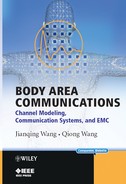Preface
The past decades have witnessed wide demand and applications for wireless communications in the human body area, that is, in the immediate environment around a human body. These demands and applications especially focus on wireless transmission and networking of personal information for user identification, healthcare and medical applications. Body area communication techniques make this more feasible. Compared with classical wireless communications, the human body acts as a communication medium either passively or favorably in body area communications. This is no doubt a kind of novelty in the context of classical wireless communications. As expected, the human body exhibits various different features from the typical wireless medium, that is, air, when it is used as a communication medium. Nowadays, more and more people are trying to uncover its intrinsic mystery so as to profit from the expected communication purposes.
As noticed by many researchers in this area, body area communications is an emerging technique which exhibits very good prospects not only in entertainment and user identification but also in healthcare and medical applications. The required knowledge ranges from wireless communications to bio-electromagnetics. In fact, we have been working in wireless communications for many years. The first author spent the first six years on completion of his doctoral work in developing wireless transceivers/systems for mobile communications and personal computer communications in both industry and research institutions, and then began bio-medical electromagnetic compatibility research after moving to a university. In 2005, when the first author became a full professor, it was felt that his background in both wireless communications and bio-electromagnetics would be very suitable to pursue this new research area. This triggered our full-scale research on body area communications.
Until now, however, there has been no textbook which systematically and completely covers this area and provides an introductory course for newcomers to this field. Two years ago, we started a course in this area for graduate students at the Nagoya Institute of Technology and for undergraduate diploma/master students at Dresden University of Technology, respectively. During the preparation of the lecture materials for these courses, we thought about how to gather our research to produce a systematic and introductory work. Fortunately, Mr James Murphy, a senior commissioning editor at John Wiley & Sons provided us with such a valuable opportunity. Following his kind invitation, we met him at an international conference in 2010 and discussed the contents of this book.
This book attempts to provide an introductory course for graduate students and newcomer engineers/researchers who need to know about or intend to be involved with body area communications. The book starts with an introduction to basic electromagnetic properties and modeling methods of the human body in various frequency bands that are available for body area communications. Next, the representative analysis techniques for body channel modeling are introduced. Based on the basic knowledge, the book focuses on three major areas: channel modeling, modulation/demodulation communications performance and electromagnetic compatibility considerations in body area communications. Most of the contents is based on the research in our laboratories.
The following topics will be described in detail from the viewpoint of an introductory course:
- Available frequency bands and expected applications for body area communications.
- Electromagnetic properties of the human body in various frequency bands, and how to model them.
- Major propagation mechanisms in various frequency bands.
- Channel models for on-body communication and in-body communication.
- Modulation and demodulation schemes used in body area communications and their analytical error probabilities.
- Link budget, bit error rate performance, RAKE and diversity reception for various on-body and in-body modulation/demodulation schemes in the available frequency bands.
- Specific absorption rate analysis for human safety evaluation in the available frequency bands.
- Modeling of electromagnetic interference with implanted cardiac pacemakers, based on both electromagnetic field approach and electric circuit approach.
- Useful computer codes for channel model generation, bit error rate analysis and specific absorption rate evaluation.
The completion of this book has been achieved by selfless contributions and help from many people. First, we would like to express our deep gratitude to the commissioning editor, Mr James Murphy, for providing us with this valuable writing opportunity, and to the project editor, Ms Shelley Chow, for her great assistance and patience in handling our manuscript. Without their support and effort it would have been impossible to publish this book. Secondly, we would like to take this opportunity to acknowledge the five anonymous referees who provided many constructive comments and suggestions, which helped us to finally form the framework of this book. Thirdly, we would like to thank our colleagues and students in our laboratory at the Nagoya Institute of Technology, especially Dr Daisuke Anzai and Dr Jingjing Shi for their contributions to the analytical and experimental data in this book. Finally, we also want to thank our families, Sufang, Moe and Mizuki in the first author's family, and Hui and Nina in the second author's family. We are sorry that we had to spend most of our spare time in writing this book rather than being able to spend our time with them. We are grateful to them for their support and understanding.
We sincerely hope that this book is both of interest and useful as an introduction for newcomers to this emerging and exciting research area.
Jianqing Wang
Nagoya Institute of Technology
Qiong Wang
Dresden University of Technology
